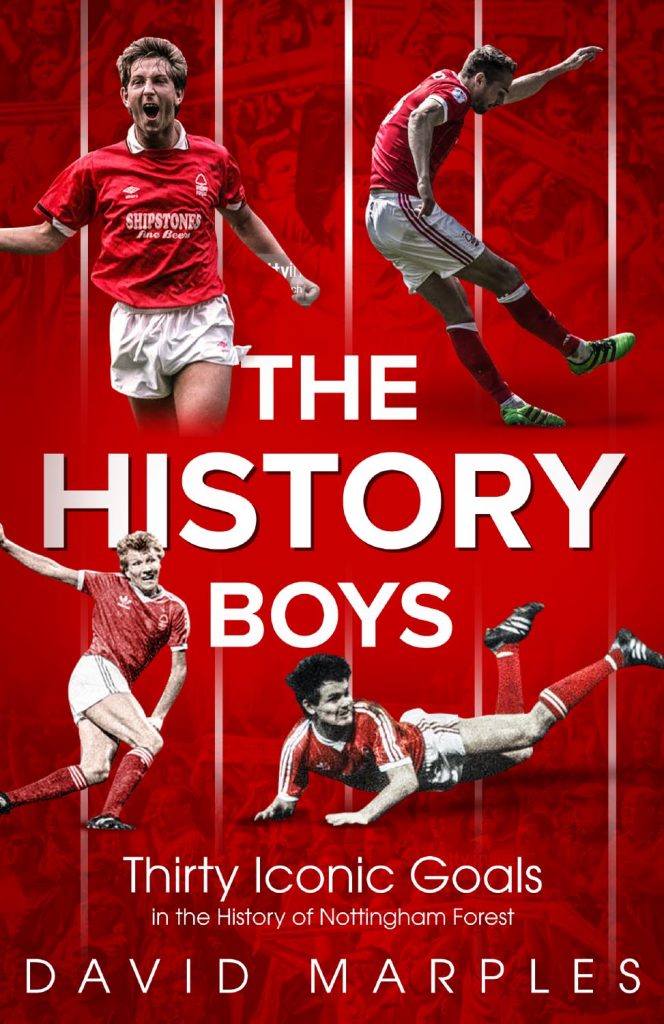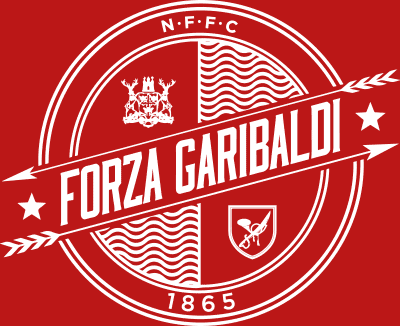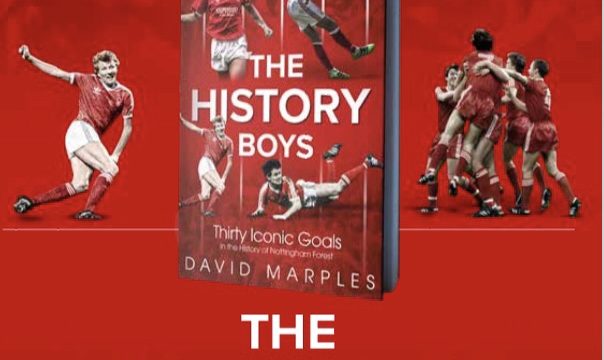The History Boys – Q&A with David Marples
At the beginning of September a new Forest book named The History Boys was released. It’s author, David Marples, may be familiar to some of you already as one of the creators and writers of the joyous quarterly publication Bandy & Shinty.
Like other Forest books that precede it, The History Boys covers our rich history yet it digs into a wide span from the sixties right up until 2017 focusing on certain players and, in particular, iconic moments that they served up while wearing the Garibaldi Red. The book also includes some wonderful illustrations by David’s Bandy & Shinty colleague Sean Hockett which add some colour (evocatively and literally) to the words.
What I was particularly enthused about is how it gave younger supporters, those like me who missed out on the peak years under Clough, an opportunity to read about our own moments. Ben Osborn’s last minute strike against Derby or Julian Bennett’s kaboom against Yeovil in 2008 do not stand toe to toe with Colin Barrett’s swivel and volley against Liverpool in ’78 but these are our moments, all that some of the fanbase have. We know it’s been a torrid twenty years but The History Boys at least offers up a few smiles of recollection for those who have only ever known Forest as, at best, a plodding Championship side. It’s one of many reasons why I would heartily recommend you treat yourself to a copy of it or gift it to a relative or friend.
David agreed to answer a few questions to explain a little bit more what his book is about.
1. Your writing is already familiar to many of us who have read your pieces within Bandy & Shinty and, before that, the In the Top One website. Is this your first actual book?
It is. A while ago I self published a book containing various bits and pieces on the 2012-13 season, but that doesn’t really count. This is indeed my first actual book.
2. What made you choose the topic of iconic goals?
The idea came from various places to be honest. I recall reading a piece by Nick Miller for The Guardian about Des Walker’s solitary goal against Luton Town and enjoying it immensely. I found myself wondering about other significant Forest goals and pursued it from there.
Each club has their own stories, myths and legends that fans buy into. Some of these are quite localised and shared only by fans of that club while others are widely known in football in general. Take Brian Rice’s goal against Arsenal at Highbury in the FA Cup in 1988 – Arsenal fans have probably forgotten about that game long ago and would no doubt look at you in a deeply quizzical manner should you mention Brian Rice to them but for Forest fans, certainly those of a certain age, it is a touchstone in the club’s history: a shared story, our very own ‘where were you when…?’ moment. That kind of thing fascinates me.
Besides, as much as we all enjoy a tactical battle on the pitch or a wonderful piece of defending, it’s goal that we really crave seeing. It is goals that outlive the dreary 0-0 draws, the hours spent on the motorways, the evenings spent freezing with soggy socks. Goals make it all worthwhile and some even define whole careers.
3. In the 153 years of Nottingham Forest it must have been difficult to narrow it down to just thirty. How did you settle on the chosen moments and were there any goals in particular that you really struggled to leave out?
I started with a list of 50 goals. There are some that probably deserve to be in there yet aren’t and vice versa but I’ll leave that for readers to argue about.
The really difficult choice was deciding which goal to focus on when the player in question had a few iconic goals under their belt. The best illustration of this is probably Jonny Metgod. I decided to focus on his last minute, beautifully flighted free kick winner against Manchester United rather than that one against West Ham United. The context of the goal sometimes came into play regarding such decisions – few can recall the final score of the game against West Ham yet there are few things better in football – maybe in life – than going two goals down yet winning 3-2 in the last minute. It’s a similar story regarding Garry Parker who can boast a fair number of truly iconic goals. 
Deciding which Frank Clark goal to include was fairly straightforward though.
4. Given the multitude of options available a second volume could be considered perhaps?
Maybe. I genuinely think there is another volume’s worth of iconic goals and players to celebrate. Garry Birtles’ goal against Liverpool in the European Cup, Lewis McGugan’s barely believable free kick against Ipswich Town, Roy Dwight’s in the 1959 FA Cup Final, Nigel Jemson’s against Oldham to secure the League Cup, Tommy Gaynor’s against Huddersfield and Kenny Burns’ against Barcelona in the Super Cup readily spring to mind.
There are also some wonderful players that merit discussion and celebration too: David Johnson, Tony Woodcock, Martin O’Neill and Peter Davenport (his goal against Eindhoven is pretty special) to name just a few.
5. Behind each moment you dig a little deeper into the man behind the moment which includes speaking with these players and getting their first-hand account on the goal but also their time with Forest. How easy was it to track these players down and what was the reaction from like from them when you explained that you wanted to include them?
I was lucky enough to be able to speak to a good proportion of the players featured for which I am deeply grateful. It is a bit of cliché but they were all genuinely lovely and hugely accommodating.
It’s interesting how players can recall in precise detail specific moments in their career and can take you step by step through them. Jonny Metgod’s dissection of his approach to free kicks was astonishingly detailed and enlightening, John McGovern spoke eloquently about his role in the team and Frank Clark chuckled warmly though his account of his goal.
Perhaps most heart warming is how fondly all those I spoke to feel about the club then and now. There is something special about this club of ours and it has so many people rooting for it.
6. When we first spoke about this book many, many months ago I remember remarking that I particularly admired that the cover which, Colin Barrett aside, featured players who probably aren’t the ones you’d usually see on the face of a Forest book. Messrs Hodge, Parker and Cohen have all contributed greatly to different teams at this club and it’s refreshing to see players of that ilk recognised.
Names such as Blackstock sit alongside Storey-Moore and Collymore. Presumably that spread of players and eras was something you wanted to work into the book?
Definitely. I was conscious of covering a range and the goals covered span from 1967 to 2017. Dexter Blackstock might well raise an eyebrow or two but his goal against Bristol City was huge in securing our survival: another relegation back to League 1 so soon after getting out would have been disastrous and probably have broken some fans for good. Players like Scot Gemmill too – criticised by some but a wonderfully gifted player who possibly doesn’t get the recognition he deserves as a Forest player.
7. Interestingly not every goal is a ‘goal’ in this book though is it?
Admittedly, the title is a little misleading since technically, the book covers 29 goals and one save – Peter Shilton’s against Coventry City to secure a point and the league title.
Rightly or wrongly, for most, saves aren’t as sexy as goals.
8. Of the 30 which is your favourite? No sitting on the fence!
I guess the one that meant the most to me at the time was Neil Webb’s in the League Cup Final against Luton Town. To see your team win a cup at Wembley is a memory I treasure.
Emotionally speaking, Nigel Clough’s goal to win a crazy game at Old Trafford was special too. It might not be one that many recall but he was such a special player and unbelievably, underrated I think. That goal was special though: yellow kit, last minute winner, terracing and at Old Trafford. Brian’s little jig on the touchline when Nigel scored might well be my most favourite thing in football.
Paul McGrath tells a story in his autobiography about how Graham Taylor felt the key to stopping Forest in the mid to late 80s was preventing Nigel having the ball. Taylor figured that everything Forest did went through him. I especially enjoyed writing the section on Nigel Clough.
9. And how many did you witness in the flesh? Surely there must be people out there who have seen all thirty? Do you know anyone or have you met anyone that has?
I’m not saying since there are some very iconic goals in there that for one reason or another, I didn’t see! I definitely think there will be some good folk out there who have seen all 29 (and one save). If they have, they have witnessed some very special moments and I for one would be incredibly envious.
It would be wonderful if everyone featured in the book signed their section – such a copy could raise a healthy amount of money for charity.
10. Finally – Where can we buy the book?
Waterstones in Nottingham. At the time of writing, it’s in the ‘Sports Hardbacks’ section near the main entrance and in the football section too upstairs. Yes, of course I’ve checked!
You can also buy it online from a number of places: Pitch Publishing, WHSmiths, Waterstones and Amazon. It is also available on Kindle and ibooks too.

